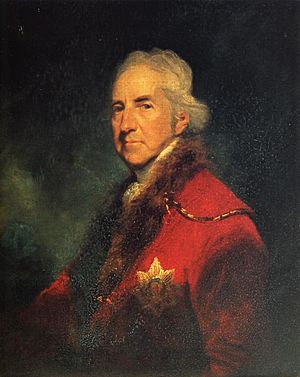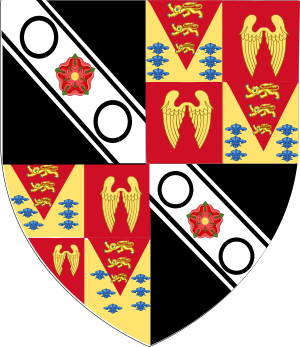Francis Seymour-Conway, 1st Marquess of Hertford facts for kids
Quick facts for kids
The Most Honourable
The Marquess of Hertford
|
|
|---|---|

Portrait by Joshua Reynolds
|
|
| Lord Lieutenant of Ireland | |
| In office 7 August 1765 – October 1766 |
|
| Monarch | George III |
| Preceded by | Thomas Thynne, 1st Marquess of Bath |
| Succeeded by | George Hervey, 2nd Earl of Bristol |
| Personal details | |
| Born |
Francis Seymour-Conway
5 July 1718 |
| Died | 14 June 1794 (aged 75) |
| Citizenship | British |
| Spouse | Lady Isabella Fitzroy (m. 1741) |
| Children | 13 |
Francis Seymour-Conway, 1st Marquess of Hertford was an important British politician and courtier. He was born on July 5, 1718, and passed away on June 14, 1794. He held many important jobs, including being the King's representative in Ireland for a short time. He also owned a lot of land there.
Early Life and Family
Francis Seymour-Conway was born in Chelsea, London. His father was Francis Seymour-Conway, the 1st Baron Conway. When his father died in 1732, Francis became the 2nd Baron Conway.
After his father's death, he spent a few years traveling. He visited Italy and Paris. When he returned to England, he took his place in the House of Lords in November 1739. His younger brother, Henry Seymour Conway, also became a famous politician and soldier.
A Career in Politics
In August 1750, Francis Seymour-Conway was given new titles. He became Viscount Beauchamp and Earl of Hertford. These titles had been held by an ancestor, Edward Seymour, 1st Duke of Somerset, a long time ago.
From 1751 to 1766, he worked for the King. He was a Lord of the Bedchamber for both King George II and King George III. In 1756, he was made a Knight of the Garter. This is a very special honor. The next year, he became the Lord-Lieutenant for the county of Warwick and the city of Coventry.
In 1763, Lord Hertford became a Privy Councillor. This meant he was a trusted advisor to the King. From October 1763 to June 1765, he served as an ambassador in Paris. He was very good at this job. The famous writer David Hume worked for him there. Hume said Lord Hertford was a very honest and kind man. He also said he had a good mind and polite manners.
In August 1765, Lord Hertford was chosen for a very important role. He became the Lord Lieutenant of Ireland. This meant he was the King's main representative in Ireland. People in Ireland were happy about his arrival. They believed he would be a good leader because of his character and his land in Ireland. However, he only stayed in Ireland for one parliamentary session. He returned to London to continue his work for the King. He was appointed Lord Chamberlain from 1766 to 1782, and again in 1783.
In July 1793, he received his highest titles. He was made Marquess of Hertford and Earl of Yarmouth. He enjoyed these new honors for almost a year. He passed away on June 14, 1794, at the age of 76. He died after a small injury he got while riding. He was buried in Arrow, Warwickshire.
Marriage and Children
Lord Hertford married Lady Isabella Fitzroy on May 29, 1741. Lady Isabella was the daughter of Charles FitzRoy, 2nd Duke of Grafton. Her grandfather was an illegitimate son of King Charles II.
Lord and Lady Hertford had thirteen children together:
- Francis Seymour-Conway, 2nd Marquess of Hertford (born 1743)
- Lady Anne Seymour-Conway (born 1744)
- Lord Henry Seymour-Conway (born 1746)
- Lady Sarah Frances Seymour-Conway (born 1747)
- Lord Robert Seymour-Conway (born 1748)
- Lady Gertrude Seymour-Conway (born 1750)
- Lady Frances Seymour-Conway (born 1751)
- Rev. Hon. Edward Seymour-Conway (born 1752)
- Lady Elizabeth Seymour-Conway (born 1754)
- Lady Isabella Rachel Seymour-Conway (born 1755)
- Admiral Lord Hugh Seymour (born 1759)
- Lord William Seymour-Conway (born 1759)
- Lord George Seymour-Conway (born 1763)
Lord Hertford's wife, Isabella, passed away in 1782. She had been caring for their grandson and caught a bad cold. She was known for being a very loving and helpful wife. After her death, Lord Hertford sold their home called Forde's Farm. The estate was later rebuilt and renamed Boyle Farm.



